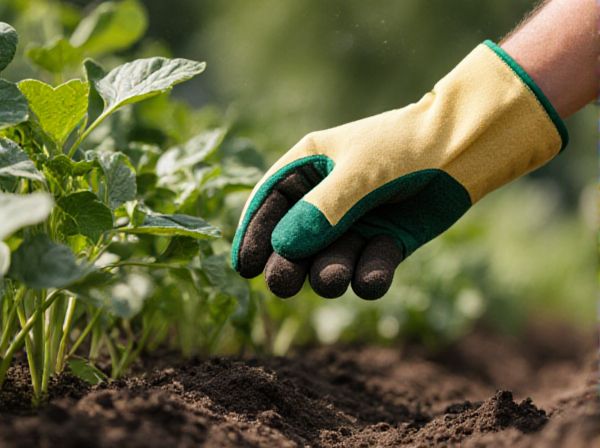
Crop rotation vs continuous cropping Illustration
Crop rotation disrupts pest life cycles by alternating different crops, reducing the buildup of specific pests and diseases in the soil. Continuous cropping creates a stable environment for pests, increasing their population and the risk of infestations. Implementing crop rotation enhances soil health and pest management, leading to higher crop yields and sustainable farming practices.
Table of Comparison
| Aspect | Crop Rotation | Continuous Cropping |
|---|---|---|
| Pest Management | Reduces pest buildup by disrupting pest life cycles and host availability. | Increases pest population due to constant host presence and favorable conditions. |
| Soil Health | Improves soil fertility and microbial diversity, limiting pest outbreaks. | Depletes soil nutrients, weakening plant resistance and promoting pests. |
| Disease Incidence | Reduces soil-borne diseases related to pest vectors by alternating crops. | Elevates disease risk as pathogens accumulate continuously. |
| Yield Stability | Enhances yield by minimizing pest-induced damage and improving soil conditions. | Reduces yield over time due to increased pest pressure and soil degradation. |
Understanding Crop Rotation and Continuous Cropping
Crop rotation involves alternating different crops in a specific sequence to disrupt pest life cycles and improve soil health, reducing the reliance on chemical pesticides. Continuous cropping, growing the same crop repeatedly on the same land, increases vulnerability to pest infestations and soil nutrient depletion, often leading to higher pest management costs. Understanding these practices is essential for sustainable agriculture, as crop rotation enhances biodiversity and pest resistance while continuous cropping can exacerbate pest-related challenges.
Key Differences Between Crop Rotation and Continuous Cropping
Crop rotation involves alternating different crops on the same land to enhance soil fertility and reduce pest buildup, while continuous cropping grows the same crop repeatedly, often leading to increased pest pressure and soil degradation. Crop rotation disrupts pest life cycles, minimizing infestations, whereas continuous cropping promotes pest adaptation and infestation intensity. Key differences include pest management efficacy, soil health impact, and long-term sustainability of agricultural productivity.
Impact of Crop Rotation on Pest Management
Crop rotation disrupts pest life cycles by alternating host crops, reducing pest populations and minimizing the need for chemical pesticides. Continuous cropping creates a stable environment for pests to thrive, leading to increased infestations and resistance issues. Integrating diverse crop species enhances natural pest control and promotes soil health, ultimately supporting sustainable agriculture practices.
Pest Risks Associated with Continuous Cropping
Continuous cropping increases the risk of pest outbreaks by providing a consistent habitat and food source for pests, leading to population build-up and reduced natural predator presence. Crop rotation disrupts pest life cycles by alternating host plants, thereby limiting pest multiplication and disease incidence. Effective pest management strategies leverage crop rotation to mitigate infestations and maintain soil health.
Benefits of Crop Rotation for Soil Health and Yield
Crop rotation enhances soil health by preventing nutrient depletion and reducing the buildup of pests and diseases common in continuous cropping systems. This method improves soil structure and increases microbial diversity, leading to better nutrient cycling and higher crop yields. Consistent rotation of crops also minimizes the risk of soil erosion and maintains long-term agricultural productivity.
How Continuous Cropping Influences Pest Populations
Continuous cropping significantly increases pest populations by providing a stable, unchanging habitat that supports the rapid buildup of pest species such as aphids, nematodes, and fungal pathogens. This practice depletes soil nutrients and biodiversity, weakening plant defenses and facilitating pest outbreaks. In contrast, crop rotation disrupts pest life cycles and reduces the prevalence of species-specific pests, improving overall pest management and soil health.
Effective Pest Control Strategies with Crop Rotation
Crop rotation disrupts pest life cycles by alternating host plants, reducing pest populations and minimizing resistance buildup compared to continuous cropping. Diverse crop sequences enhance soil health and promote beneficial predators, naturally suppressing pests without excessive chemical use. Implementing strategic crop rotation plans improves long-term pest management, leading to sustainable agricultural productivity.
Challenges of Switching from Continuous Cropping to Crop Rotation
Switching from continuous cropping to crop rotation presents challenges such as managing initial yield reductions due to crop-specific nutrient demands and pest population shifts. Farmers must adapt to altered pest life cycles and increased labor for diverse crop management practices. Soil fertility management becomes more complex, requiring careful selection of rotation crops to optimize nutrient cycling and pest suppression.
Real-World Examples: Crop Rotation Reducing Pest Infestations
Crop rotation significantly reduces pest infestations by interrupting the life cycles of crop-specific pests, as demonstrated in cotton farming where rotating with legumes decreases nematode populations. In corn production, alternating with soybean crops lowers rootworm damage, enhancing yield stability and reducing pesticide reliance. Real-world evidence from these practices highlights their effectiveness in sustainable pest management and soil health improvement.
Best Practices for Gardeners: Choosing the Right Cropping System
Crop rotation significantly reduces pest populations by interrupting their life cycles and improving soil health, making it a best practice for sustainable gardening. Continuous cropping often leads to the buildup of specific pests and diseases in the soil, increasing the need for chemical interventions. Gardeners should select crop rotation plans tailored to their local pest pressures and soil conditions to optimize plant health and minimize pest infestations naturally.
Crop rotation vs continuous cropping Infographic

 gardendif.com
gardendif.com